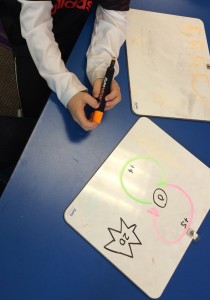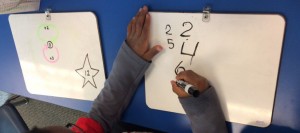Do you ever write a blog post and leave it in “drafts” for so long… you forget your wrote it? That happened with this post. This post was initiated last spring and completed today with some additions.
For too long now, we have equated “learning” with the “result of being taught.” I’m not refuting the fact that we can learn from great teachers… in fact, that’s not my point at all. Teachers make a significant impact in whether students have an opportunity to learn or not in a school environment.
Rather, the point I want to make is that, for too long, we have equated learning with consuming what has been delivered TO learners. Traditional schooling has tried to make learning a passive activity, and I feel the damage we’re doing to children is resulting in generations of people who cannot think for themselves. Additionally, they have a difficult time learning anything that is new or unfamiliar – if a problem is put in front of them that doesn’t resemble a problem they’ve already seen, most students will struggle.
Recently, I’ve noticed a lot of educators talking about how we need to help students learn “how to learn.” I vehemently disagree. Children come to us as innate learners. If anything, most schooling conditions children to turn off their learning brains and substitute with their compliance/consumer brains. If you think you have students who need to be taught how to learn… you’re wrong. They just need help reprogramming themselves to actually learn, and that requires removing almost everything they have been conditioned to do in a traditional school environment.
Learning isn’t memorizing something and then performing on a test. If you disagree with me, pull out a test from one or two months ago and give it to your students. Most of them will not be able to pass this test, even if they aced it before. Now, if those same students created something through building, baking, composing, painting, etc. – something where the learning was meaningful, my guess is that they would be able to replicate (and most likely improve) their creations over and over again.
When I speak to other educators about learning, they usually agree… except when it comes to facts and skills they strongly believe must be TAUGHT.
EXAMPLE: I am constantly asked how I TEACH my students to read, considering I do not focus on teaching and drilling sight words, phonemic awareness, etc.
I usually answer, “I don’t TEACH my students to read.”
I get the same questions when it comes to math… “How do they learn math if you don’t practice math facts?” *
And the question, especially from other educators, “How will your students learn to read, learn their math facts (etc.) if you don’t TEACH them?”
Yet… my students DO learn to read. They do learn their math facts, and so, SO much more!
How is it at all possible that the students in my classroom are reading, are applying math facts to actual math problems that they find (not necessarily problems I give them to solve)?
The answer is simple, and it’s one we’ve forgotten over years – nearly a century really- of delivering information to kids to “learn.” Consuming information that is delivered from a teacher is not LEARNING.
When I memorize a bunch of stuff that someone else decides is important for me to know, that process takes one of the most important facets of learning out of the learners hands– the agency of the learner.
Human beings learn about the world around them when they’re curious… when they see a need to know and understand something… and then want to USE that newly found knowledge/skill. Good teachers know this and help provide an environment where kids are able to learn and pursue those things that make them curious. Master teachers know how to expose children to new experiences – those they may not discover on their own – to create new opportunities for learning to occur.

Inventing, planning, and building a new form of mass transportation for water.
When WE (educators) decide what students should learn, it becomes a chore. Curiosity lessens. And the opportunity to actually use that new knowledge is rarely provided outside an artificial environment.
Case in point… I have observed years and years of children sitting in science class “learning” from a textbook. THAT is not science! That’s reading comprehension. When you have never practiced actual science and only read about it… that is not learning science.
In discussions with other educators, I often hear things along the lines of “Well, if I don’t explain it to them first, how will they learn it?” This line of thinking misses the beauty of true learning. Ask any adult what they remember the most from high school. I guarantee it won’t be anything they were “taught” and memorized for a test. Delivered information resides in our short-term memory if we don’t do anything beyond memorizing it. We KNOW this… it’s not new to teachers. We learn that memorization is the lowest order of thinking. So why do we still concentrate more in this area in education than the others? Short answer: it’s the quickest and easiest to test. Efficiency for the win (or not). The longer answer is much more complicated.
I’ve written several posts like this before with explanations about what learning IS and what it IS NOT. So have a lot of other people. I’ll add some to comments and welcome your additions as well!
So to get back to my original example (and reason for writing this post)…
The answer to the questions I get from educators who see what we do at Anastasis Academy – and wonder how on earth my K/1s learn how to read, write, understand math, etc. -without teaching via traditional methods educators are used to seeing – is THIS:
I don’t teach kids to read.
I don’t teach kids to write.
I don’t teach kids to memorize math facts… or vocabulary… or any of those other delivered items/standards to which we have clung so tightly in traditional education.
I facilitate a learning environment where they are curious.
I facilitate a learning environment where they want to learn to read.
I facilitate a learning environment where they want to make sense of numbers.
(I could go on, but I think you get the picture.)
We do not drill phonics or math facts. We read all the time. We talk about letters, sounds, word endings, rhyming words, patterns, etc. IN THE CONTEXT OF WHAT WE ARE LEARNING. Always.
Let me emphasize that…
Yes, sometimes we’ll stop and talk about how verbs in the past tense sound like they end in a “t,” but the patterns we see in our books are “-ed.” We remark about this pattern every time we see it, and then we also start noticing it in our writing.
Pretty soon, the students start to think and edit themselves in their writing of past tense verbs. It makes sense to them, because it comes up in the context of what they’re already doing. These types of little mini or “pop out” lessons happen all the time, but the most important part is this: it’s always in the context of what we’re learning. I cannot stress this enough.
So if you ask me how I teach my kids to read if I don’t focus on all the traditional 20th/21st century methods of teaching reading, I will tell you…
I don’t teach them to read. They LEARN to read.
You can substitute any other concept/skill in the above sentences, because the emphasis is always on LEARNING, not teaching.
*Two of my “learning and math” posts that are relevant:




